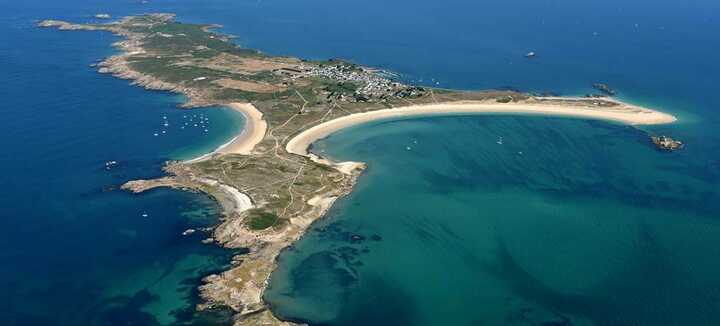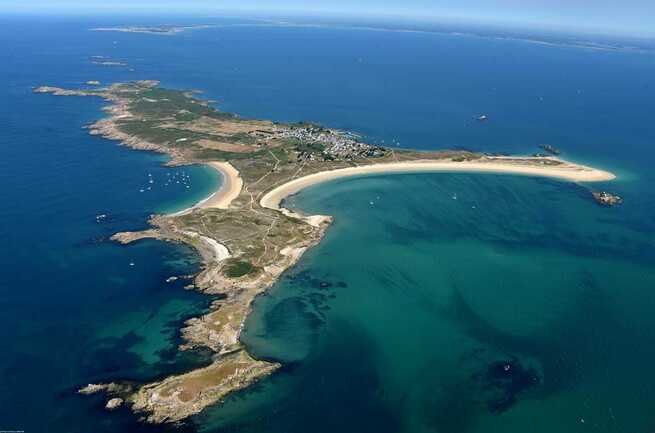
Houat - Tour de l'Île
Features of the route
Difficulty
Easy
Length
3h30
Distance
14.3km
Municipality of departure
Île-d'Houat
Duration: 3h30
Distance: 14.3 km (Easy)
Follow the coastal path - Metal-tipped poles prohibited
Houat's high granite cliffs are an extension of the Quiberon peninsula, to which it was once attached. The village is clustered around the fishing port, an important activity. The coastline is of rare beauty, and the flora is rich and diverse.
Step by step :
Departure: From the landing stage, take the coastal path to the right.
1- Sheltered from the prevailing winds, the north coast seems a little less rugged than the south-west. From Beg Carpaliée to Beg-er-Vachif, the high, dry moorland slopes down to the sea. Near the village, overgrown meadows and gardens with gorse, heather, blackthorn, eagle fern, nesting passerines, herring gulls, green and wall lizards.
2- At Beg-er-Vachif, view of the islets Guric and Séniz, linked to the island by a small sandy tombolo that appears at low tide: herring, brown and great black-backed gulls, one of the main colonies of crested cormorants and oystercatchers.
3- The wild, unspoilt south coast, between cliffs and coves, is unique in Morbihan. Highlights: Treac'h-er-Venigued cove, Beg-er- Vachif (view of Chaussée du Béniguet, mainland), "er Beg" promontory (view of Belle-Île, Hoedic, Île aux Chevaux, Treac'her-Goured). Notable species: isoëte des sables, ophioglosse du Portugal, great raven, motteux traquet, tadorne de Belon.
4- In the center, a formerly cultivated plateau has been levelled by sea abrasion and is being colonized by heathland. Seen from the fort, it constitutes a preserved landscape entity: high moorland with European gorse, patches of dune grassland, fallow meadows. Several megalithic monuments dating back to the Neolithic period (7,000 to 4,500 years BC) can also be seen here.
5- The dunes and beaches of Treac'h-er-Goured and Treac'h-Salus form one of the most beautiful dunes in Brittany, home to many remarkable species, including the abundant sea lily. The skylark and the clammy wheatear nest here.
6- The large rocky mass of Er-Yoc'h islet is home to a large colony of English shearwaters, very rare in France.
Distance: 14.3 km (Easy)
Follow the coastal path - Metal-tipped poles prohibited
Houat's high granite cliffs are an extension of the Quiberon peninsula, to which it was once attached. The village is clustered around the fishing port, an important activity. The coastline is of rare beauty, and the flora is rich and diverse.
Step by step :
Departure: From the landing stage, take the coastal path to the right.
1- Sheltered from the prevailing winds, the north coast seems a little less rugged than the south-west. From Beg Carpaliée to Beg-er-Vachif, the high, dry moorland slopes down to the sea. Near the village, overgrown meadows and gardens with gorse, heather, blackthorn, eagle fern, nesting passerines, herring gulls, green and wall lizards.
2- At Beg-er-Vachif, view of the islets Guric and Séniz, linked to the island by a small sandy tombolo that appears at low tide: herring, brown and great black-backed gulls, one of the main colonies of crested cormorants and oystercatchers.
3- The wild, unspoilt south coast, between cliffs and coves, is unique in Morbihan. Highlights: Treac'h-er-Venigued cove, Beg-er- Vachif (view of Chaussée du Béniguet, mainland), "er Beg" promontory (view of Belle-Île, Hoedic, Île aux Chevaux, Treac'her-Goured). Notable species: isoëte des sables, ophioglosse du Portugal, great raven, motteux traquet, tadorne de Belon.
4- In the center, a formerly cultivated plateau has been levelled by sea abrasion and is being colonized by heathland. Seen from the fort, it constitutes a preserved landscape entity: high moorland with European gorse, patches of dune grassland, fallow meadows. Several megalithic monuments dating back to the Neolithic period (7,000 to 4,500 years BC) can also be seen here.
5- The dunes and beaches of Treac'h-er-Goured and Treac'h-Salus form one of the most beautiful dunes in Brittany, home to many remarkable species, including the abundant sea lily. The skylark and the clammy wheatear nest here.
6- The large rocky mass of Er-Yoc'h islet is home to a large colony of English shearwaters, very rare in France.


